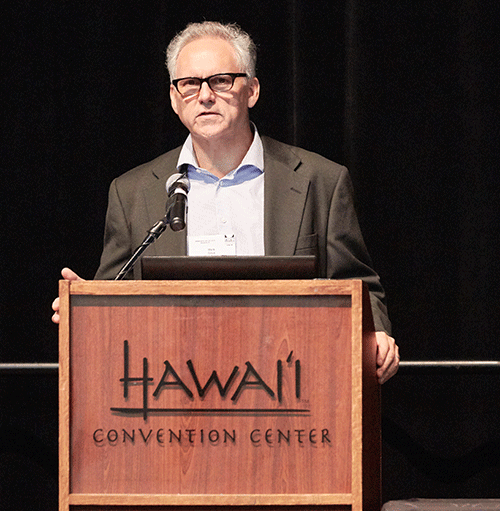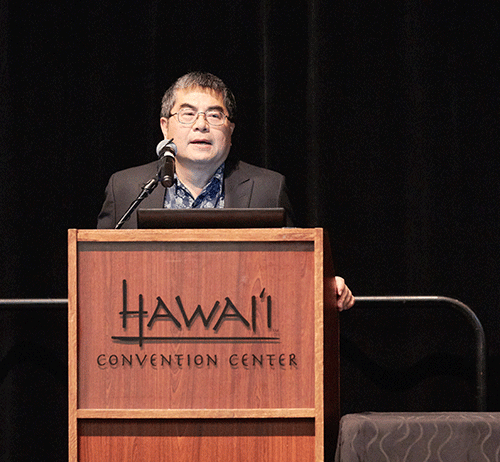
Mark Glick speaking at the 6th International ECS Electrochemical Energy Summit.
Global investments in renewable energy have continued to grow over the past five years, exceeding $329 billion in 2015. As technological solutions that drive down costs continue to emerge, more countries are adopting standards to encourage the growth of renewable energy. In the United States, Hawaii is looking to set the standard in clean, sustainable energy for the entire country.
During the October PRiME 2016 meeting in Honolulu, HI, policy makers and researchers from around the world came together for the 6th International ECS Electrochimical Energy Summit, focused on Recent Progress in Renewable Energy Generation, Distribution, and Storage.
“For us, it’s important that we continue to bring the opinion leaders as well as the leading scientists and researchers to Hawaii because we believe that we’re the center of a lot of important activity,” Mark Glick, summit moderator and Hawaii State Energy Office Administrator, tells ECS. “There’s nothing more exciting to demonstrate relevancy than to have the leading scientists in the world in the largest research conference of its kind come to Hawaii.”
One hundred percent renewable standard
Since 2008, Hawaii has been on the cutting-edge of the renewable energy industry in the United States. As oil prices rocketed from $74.44 to $102 a barrel (inflation adjusted), the state found itself in a unique position to commit to greater utilization of renewable energy sources.
“After the oil price shock, we decided we needed to change our course,” Glick says. “So we set forth a renewable portfolio standard. At that time, we aimed for 40 percent renewable energy by 2030. Since then, we’ve been so successful at getting ahead of the curve on that renewable portfolio standard.”
In 2015, the state of Hawaii exceeded its goal of 15 percent renewable energy production by over 8 percent. Additionally, Hawaii’s state legislature enacted a law that mandates that all of the state’s electricity come from renewable sources by 2045. This is an effort on behalf of the Hawaiian government to save billions of dollars spent on imported fossil fuels. With the islands currently generating over 22 percent of their electricity from wind, solar, and other renewable energy resources, the state government decided to take its already established renewable energy infrastructure and drive even further progress.
While other states in the country have passed renewable portfolio standards, Hawaii is the first to have done it in the terms of a mandatory goal enacted by legislature.
Shifting of energy distribution
Bor Yann Liaw, ECS member and former Hawaii Natural Energy Institute researcher, says that the legislative mandate has helped bolster the improvement of Hawaii’s electric grid, both in generation and efficiency.

Bor Yann Liaw, former Hawaii Natural Energy Institute researcher, chaired the summit.
“Hawaii represents the highest penetration of renewable energy in the natural grid,” Liaw, chair of the summit, says. “The state has a very unique environment because every island has its own resources, and they are very different from one another.”
According to Liaw, this is what separates Hawaii’s renewable energy plan from many others. Historically, high penetration of photovoltaics into the grid has produced unpredictable and sometimes highly variable outputs. The intermittent nature of solar and other renewable energies often contrasts with traditional centralized generation, which produces exactly what is consumed at the time.
“I think we’re departing from a conventional centralized grid system,” Liaw says. “For example, the PV penetration on rooftop solar provides a very vivid contrast to the conventional wisdom of this kind of centralized distribution.”
For Liaw, this departure from traditional electricity distribution could mean small communities, or even a single household, could become independent from the grid. Much of this progress, however, hinges on the work of Liaw and other in the field of energy storage.
Liaw recently made the move from the Hawaii Natural Energy Institute to Idaho National Laboratory, where he’s working on the total energy storage system. This means everything from advanced battery systems to fuel cell vehicles to electrified train systems. His research efforts are aimed to help solidify the commercial viability of renewable energy in large-scale society.
“Many people are beginning to see how PV and storage can actually help manage their utility needs,” Liaw says. “With a centralized generation, they focus less on the end user’s benefit, but in Hawaii, it’s the reverse. You’re really look at the market. You’re looking at the penetration, and how that impacts the societal behavior from the end user’s perspective.”
Renewable world
Technological improvements by researchers in the energy sector have helped drive a worldwide move to grid equality. With renewable prices competing favorably with coal and natural gas, markets across the globe have begun to shift in a new direction. One of the main goals in the field of energy is to further reduce the costs and raise the efficiency of these pivotal technologies.
“We’ve had a series of challenges in trying to integrate more renewable energy, more photovoltaics, distributed generation, improve our grids, and design technologies that will help us incorporate more demand response and smooth out generation throughout the day. The Electrochemical Energy Summit and PRiME are really crucial because the scientists that are members are actually creating the solutions we need,” Glick says, “Those are all solutions that ECS scientists are doing every day.”


